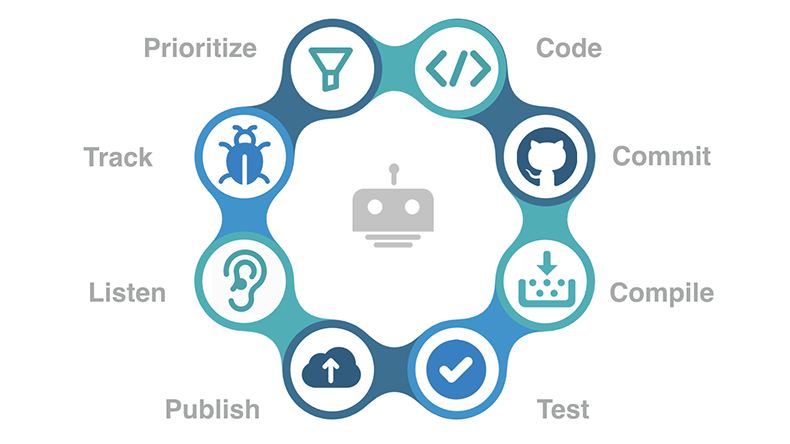Overview
Over the last 20 years we’ve put together a process that helps us build customer delight. There are eight pieces to this process, and they are all equally important. For years, we built our own proprietary tools to support most of the parts of this process. But now, there are great commercially available tools - tools we encourage you to use, too.
Our Software Development process, just like the other processes, is a cycle. So we can start anywhere.

The Cycle
Since this is a developer guide, let’s start with writing code.
Code
This is what we as software developers spend a lot of our time doing. We’ve got our favorite IDE open, we write code, we debug, we solve problems. We don’t know a software developer that doesn’t love solving problems.
When we’ve got something, we commit it to our version control system…
Commit
We commit code to a Version Control System. In our case, we use git with GitHub. There are many other version control systems out there. We used to use Subversion, but now we use GitHub. GitHub plays nicely with so many other tools and has such a rich API. But there are others worth considering: BitBucket, Mercurial, etc.
If you don’t use any version control, we beg you: please start. It’s so easy now. It lets you get back to other versions of your software before you introduced a problem. It helps you collaborate as a team. It is required for any kind of build automation. Did we mention it’s easy?
As developers, we use a modified version of GitHub Flow to create and merge pull requests into our master branch.
After we commit our code, we build it…
Compile
In addition to compiling at our desks, we have dedicated TeamCity servers that constantly build our code, and verify that it works with our master branch on GitHub. This makes sure that we don’t break each other’s ability to get the latest code and compile.
These TeamCity servers verify every commit and also build our daily releases - many of them - about every four hours. They also build our public WIP and Service Release builds.
With every new build, we test…
Test
When developers fix bugs and close issues, our internal testing staff makes sure the public build works correctly. We also rely on our customers to test WIP and Release Candidate builds.
Testing happens before and after the next step: Publishing…
Publish
Whenever we’ve got a build that is ready to go out to customers, we deploy (or publish) it.
This includes releasing …
- Downloadable installers
- SDKs
- Documentation (this here site)
…and making public announcements by email, blogs, and social media.
We plan to release new versions of Rhino the 2nd Tuesday of each month, which includes a:
- Service Release (SR) for all users who have updates enabled.
- Service Release Candidate (SRC). After the SRC goes through final testing, it becomes the next Service Release the following 2nd Tuesday. SRCs are also published weekly - typically on Tuesdays - and we encourage users to install Service Release Candidates as they help us test the next update.
- Work-In-Progress (WIP) build.
Listen
We listen in as many ways as we can:
- Chat
- Telephone Support (206) 545-6877
- Forum (Discourse)
And often, when we listen, we find problems that need to be fixed. Sometimes they’re little…sometimes they’re HUGE. We always log an issue…
Track
We log issues in YouTrack.
YouTrack works well for us because it helps us ensure that each issue gets properly tested and documented.
Prioritize
Figuring out what is the next most important thing is HARD. We talk with our customers. We talk with each other. We use Gmail, Google Drive, and Google Docs to communicate. We chat 24 hours a day on Slack.
We meet every week on Tuesday. Before we meet, we share what we’ve done in a Google Doc. In that document, we share our goals for each of the products we’re releasing next each of the feature groups we’re working on including graphs of how we’re progressing over time there are links back to our YouTrack issues and we get verbal reports from each of the people working on the features.
Also, each developer writes down what they’ve been working on, what they plan to do next, and what is getting in their way of completing their work.
Automation
And last but not least, we do a LOT of automation.
Here are some of the things we automate:
- Build every commit from every developer before it goes into our master development branch.
- Closing issues in YouTrack when fixes get merged into our master development branch by the TeamCity servers.
- Build internal and public releases on our TeamCity servers.
- Publishing new WIP releases by typing a command into Slack.
- Upload public releases to our download servers.
In Public
Up until recently, these are the parts of our processes that we’ve made public:
- Testing
- Publishing (at least you see what we publish)
- Listening
And in the last couple of years, we made our issue tracker public by switching to YouTrack. Some issues we hide from public view for security or user privacy reasons.
Something we’d like to do soon is to make even more of this public:
- Sharing some of our code as public repos on GitHub so you’ve got some real, production-hardened code examples to work from
- Letting you share fixes and improvements to our code.
- Making it easier to build plug-in projects by publishing RhinoCommon as a NuGet package.
- Helping with build automation where necessary.

